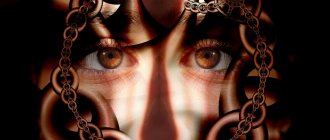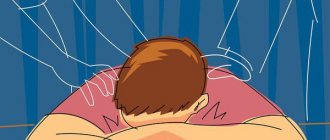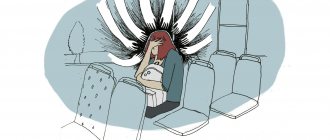Reasons for the development of the disorder
Hysterical conversion disorders have several aspects of formation and differ in some mechanisms. Their difference depends on the predominant form of different symptoms. There have long been observations that conversion disorder is the lot of women and a phenomenon of mental conflict. It is also believed that young and elderly people are predominantly prone to it, due to their character traits. The key reason for the formation of this disorder is mental instability, which undoubtedly affects all areas of life.
Conversion personality disorder is rooted in an acute psychological conflict that develops as a result of certain internal contradictions. The essence of this conflict is the fulfillment of every desire right now. Naturally, external society never strives to meet such requirements, so the conflict will only worsen. The demands that a hysteric places on others are always too high; such people do not evaluate themselves critically. This underestimation of one’s mistakes and shortcomings entails a desire for special significance and an excessive subconscious desire to turn out to be the “navel of the earth.”
Dissociative conversion disorder drives the individual to attract the environment and the desire to be taken into account by the environment. This is the driving force of such pathology. The individual simply needs to achieve the goal at all costs, and he does not look for other ways. Such a pathological reaction is not formed without cause; there are always detailed explanations, the root of which stems from childhood. Quite often, psychologically, an individual has a need to avoid some painful decisions and this subconsciously pushes him into illness. It’s easier for him to be sick to those around him, to escape responsibility and not make any demands on himself.
Often the subconscious of such a person tries to avoid something; this is an unconscious state. Hysterics are very specific people; they are unable to achieve anything through struggle and refuse reality and challenges, hiding in the shell of their symptoms. Often the desire to avoid psycho-conflict, as an internal need, becomes the root cause of pathology.
A subconscious desire to escape and avoid pain often drives individuals with conversion disorder. Sometimes this is possible in overly imperative authoritarian families, in which a person needs to be afraid, and there is no opportunity to express himself in any way. Hysteria is a very common symptom of loneliness and a feeling of worthlessness, and the sadness can be all-consuming and very painful for that individual.
Hysterical conversion disorders may have several driving factors. Biological factors are a kind of substrate for the development of such neurosis. They have hereditary roots, genetic patterns, and it is not hysteria itself that is inherent, but only a tendency, as a certain type of reaction.
Constitutional inclination is a slightly different subspecies, it is a certain type of personality. It is present in humans and gives some slight deviations during the action of certain negative factors. The formation of conversion pathologies can be influenced by concomitant somatic and somato-mental pathologies, which can aggravate the disorder, and sometimes even become a trigger for its development. Crisis periods of age are also more dangerous for the emergence of conversion disorders, especially puberty and menopause. Psychosomatic pathologies also influence hysteria; they are closely intertwined with conversion disorders.
Forecast
Symptoms of conversion disorder (CD) usually last from a few days to a few weeks and may suddenly disappear. Usually the symptom itself is not life-threatening, but complications from the symptoms or unnecessary medical tests can be debilitating.
For most people, conversion disorder symptoms improve with confidence and time. However, one in four people may experience relapses or new symptoms later. People may have longer-lasting symptoms or develop new CR if:
- delay in seeking treatment;
- symptoms appear slowly or do not improve quickly;
- they have serious mental disorders;
- they have tremors or seizures that are not caused by epilepsy.
If a separate underlying disorder is later found to be causing signs or symptoms of CD in a person, the long-term outlook (i.e., prognosis) and treatment recommendations for that person depend on the underlying disorder.
Symptoms and signs of pathology
This personality disorder has symptoms that depend on periods of crisis and on many other disorders. Psychologically, people with conversion disorders have some pathologies of a personal psychological nature. They are very characterized by demonstrative symptoms, that is, the desire to show themselves while in the adored center. Demonstrative features can be present in premorbidity, that is, before the development of the pathology itself.
Childhood mental traumas very often later appear in the symptoms of the disorder, although they are not directly heard in the individual’s speeches, since they are hidden in the subconscious. Such people have high suggestibility, a kind of suggestibility. Such individuals easily succumb to various tricks and suggestions. In this case, the pathology does not go away due to suggestions, although hypnotic therapy works well for patients. Any deprivation is unbearable for such a person.
Dissociative conversion disorder involves the conditioned pleasantness of the symptom. That is, the patient has a secondary benefit from such a pathology. This does not mean that he is a malingerer; for him, all these processes in the psyche take place unconsciously. The desirability of the symptom is most characteristic of conversion disorder. The purpose of such a gain is to retain the attention of the desired individual, and even the unconditional desire to retain love, since there is an illusion that without retention no one will need him and will remain abandoned.
The described disorder always contains an internal conflict, a certain contradiction that manifests itself in symptoms and in relationships. It is often formed from family contradictions and sexual family prohibitions, which disrupt the normal psychodevelopment of the child. There is also a family-based desire for a personal rental attitude, that is, all relationships are built through profit.
Pathogenetically, conversion disorder has a certain developmental sequence. Usually its formation occurs suddenly, but only at first glance, internally, undoubtedly, there are good reasons for this. Dissociative conversion disorder tends to remit, even after hypnotic procedures, and disorders that were triggered by traumatic life events are especially likely to return.
This disorder remits when internal problems persist; this is due to the aspect of the inevitability of experiencing internal contradictions. Particularly provocative for recurrence are situations that touch the living inner ego and bring up the same issues again. It is important to understand that the more advanced and long-standing the case, the more difficult it is to treat with any psychotherapeutic methods.
It is characteristic that a violation of this type can provoke pseudo-lesions in all mental spheres. Usually the functioning of the body is integral, but with this pathology disintegration occurs and the individual completely loses some functions, which become, as it were, turned off from the general stream of consciousness.
Affected Populations
The exact prevalence of the disorder is unknown. However, research shows that CR is the second most common reason for neurological outpatient visits after headache/migraine; it accounts for one sixth of diagnoses. This means that CR is as common as multiple sclerosis or Parkinson's disease.
Conversion disorder can affect anyone at any time, although it is rare in children under 10 years of age. CR is more likely to affect women than men for most symptoms, although when the disease occurs in patients over 50 years of age, it occurs equally in both groups.
Types of conversion disorders
The described disorders have different types depending on the symptoms. The most classic form is conversion hysteria, which is formed according to classical symptoms. Most often this is a symptom of demonstrative behavior.
Dissociative amnesia has another term - pseudoamnesia. In this case, memory is lost for certain events, usually unpleasant for the individual himself, but is perfectly preserved for most things. Naturally, dementia does not have a classical structure and memory erasure does not occur according to Ribbo’s law. The individual loses memory for basic skills and simple things, but at the same time remembers and is able to perform complex actions that require normal intelligence.
Dissociative fugue includes pseudodementia in its psycho-clinical picture, as well as inappropriate motor activity, which does not have any purpose or any composition. At this time, behavior appears outwardly ordered. Dissociative stupor is also a fairly common phenomenon among hysterics. In this case, the individual is classically immobilized and does not respond to stimuli. However, there is no physical reason for this, and if no one is watching this, then the stupor decreases on its own.
Trance states and obsession are also a subtype of conversion disorders. They occur in people with particularly unstable psyches and a significant degree of internal problems. At the same time, this manifests itself as a complete personal loss and a violation of the sense of the passage of time. These conditions are not religious enlightenment and should not be caused by other pathologies.
Dissociative disorders of motor functions are hysterical paralysis and paresis. It causes partial or complete inability to move. Closely intertwined with ataxia, imbalance. Sometimes psychogenic movement disorders may occur. A subtype of such disorders may be the occurrence of aphonia - a psychologically caused inability to speak due to loss of voice. If the vocal apparatus is not impaired, but the individual is silent, then this is called hysterical mutism.
There are also conversion disorders, which manifest themselves as seizures, similar to epileptic ones. The difference is the obvious impossibility of tracking the time when the patient is not breathing; the duration depends on the presence of spectators; such seizures rarely lead to significant trauma.
In addition to disturbances in the musculoskeletal system, there may be a disturbance in sensitivity, while the neurologist usually does not detect focal lesions, but the sensitivity of the hands and feet often disappears (like hysterical gloves and socks).
Multiple personalities are also included in conversion disorders. These may be psychotic disorders that manifest themselves as obvious disorders of consciousness, such as depersonalization cloudings. It can also be formed by the manifestation of derealization symptoms, in which contact with reality is lost.
There is also a serious section of mental disorders associated with this disease. This includes puerilism - a behavior disorder in which an adult behaves like a child: lisps and plays with toys. There may also be a feral syndrome, in which an individual begins to make some animal sounds, bark, walk on all fours and eat like an animal. Naturally, this is very noticeable and attracts a lot of attention.
Hysterical conversion disorders can manifest themselves as obvious violations of many functions; an example is Ganser syndrome; it combines a large number of different symptoms, including wildness and puerelism. There are also mixed conditions that combine several disorders from this series.
Diagnostics
Doctors first check for physical, particularly neurological, disorders that may explain symptoms by taking a thorough medical history and performing a thorough physical examination and tests.
The key to diagnosis is that the symptoms do not correspond to those due to any neurological disorder. For example, a person may shake and think the tremors are caused by a seizure disorder. But when a person is distracted, the tremor stops. In a seizure disorder, distraction does not stop the tremor.
Also, for doctors to diagnose conversion disorder, the symptoms must cause significant distress and interfere with functioning.
Once doctors determine that symptoms are not consistent with those due to a neurological disorder, a diagnosis of conversion disorder is considered. The diagnosis is made based on all the information obtained during the assessment.











